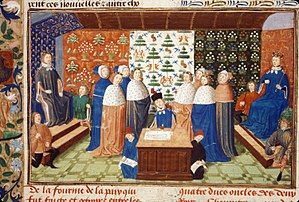This article relies largely or entirely on a single source. (March 2017) |
 | |
| Type | Temporary truce |
|---|---|
| Drafted | June 1389 |
| Signed | June 1389 |
| Effective | 18 July 1389 |
| Condition |
|
| Expiration | Set to expire July 1416; was repudiated in August 1402 |
| Signatories | |
| Parties | |
| Language | French |
The Truce of Leulinghem was a truce agreed to by Richard II's kingdom of England and its allies, and Charles VI's kingdom of France and its allies, on 18 July 1389, ending the Caroline War of the Hundred Years' War. England was on the edge of financial collapse and suffering from internal political divisions. On the other side, Charles VI was suffering from a mental illness that handicapped the furthering of the war by the French government. Neither side was willing to concede on the primary cause of the war, the legal status of the Duchy of Aquitaine and the King of England's homage to the King of France through his possession of the duchy. However, both sides faced major internal issues that could badly damage their kingdoms if the war continued. The truce was originally negotiated by representatives of the kings to last three years, but the two kings met in person at Leulinghem, near the English fortress of Calais, and agreed to extend the truce to a twenty-seven years' period. Other provisions were agreed to, in attempts to bring an end to the Papal schism, to launch a joint crusade against the Turks in the Balkans, to seal the marriage of Richard to Charles' daughter Isabella along with an 800,000 franc dowry, and to guarantee to continue peace negotiations, in order to establish a lasting treaty between the kingdoms. The treaty brought peace to the Iberian Peninsula, where Portugal and Castile were supporting the English and French respectively. The English evacuated all their holdings in northern France except Calais.
The truce was the result of a decade of failed peace negotiations and inaugurated a thirteen years peace, the longest period of sustained peace during the Hundred Years' War. During the years following the truce, Richard reneged on his agreement to assist in ending the schism, leading the French to unilaterally withdraw from the obedience of either pope and seize Avignon by military force. French foreign policy also began to focus on Italy, and Genoa became a French protectorate. In England, Richard used the lapse in fighting to attack his political enemies and confiscate their lands, which he redistributed as rewards to his supporters. He then left for Ireland to put down a revolt among the Irish chieftains, but during his absence a number of his exiled opponents returned, led by his cousin Henry of Bolingbroke, Duke of Lancaster. Henry began an insurrection and seized most of England before Richard could return. Upon his return, Richard was imprisoned, and before he was starved to death he was forced to agree to abdicate. Henry was crowned in his place. The French initially interpreted events in England as a repudiation of the truce and raised an army and put garrisons in place on the fronts. Henry IV reaffirmed the truce which remained in place for several more years.
Henry made a number of aggressive political moves against France in the following years, marrying Joanna, widow of the duke of Brittany on February 7, 1403, and forming alliances with several German rulers, including a marriage alliance with Bavaria. Scotland was the first nation to break the truce, invading England in August in coordination with a revolt in Wales. The French reentered the conflict in September 1403, landing an army in Wales.